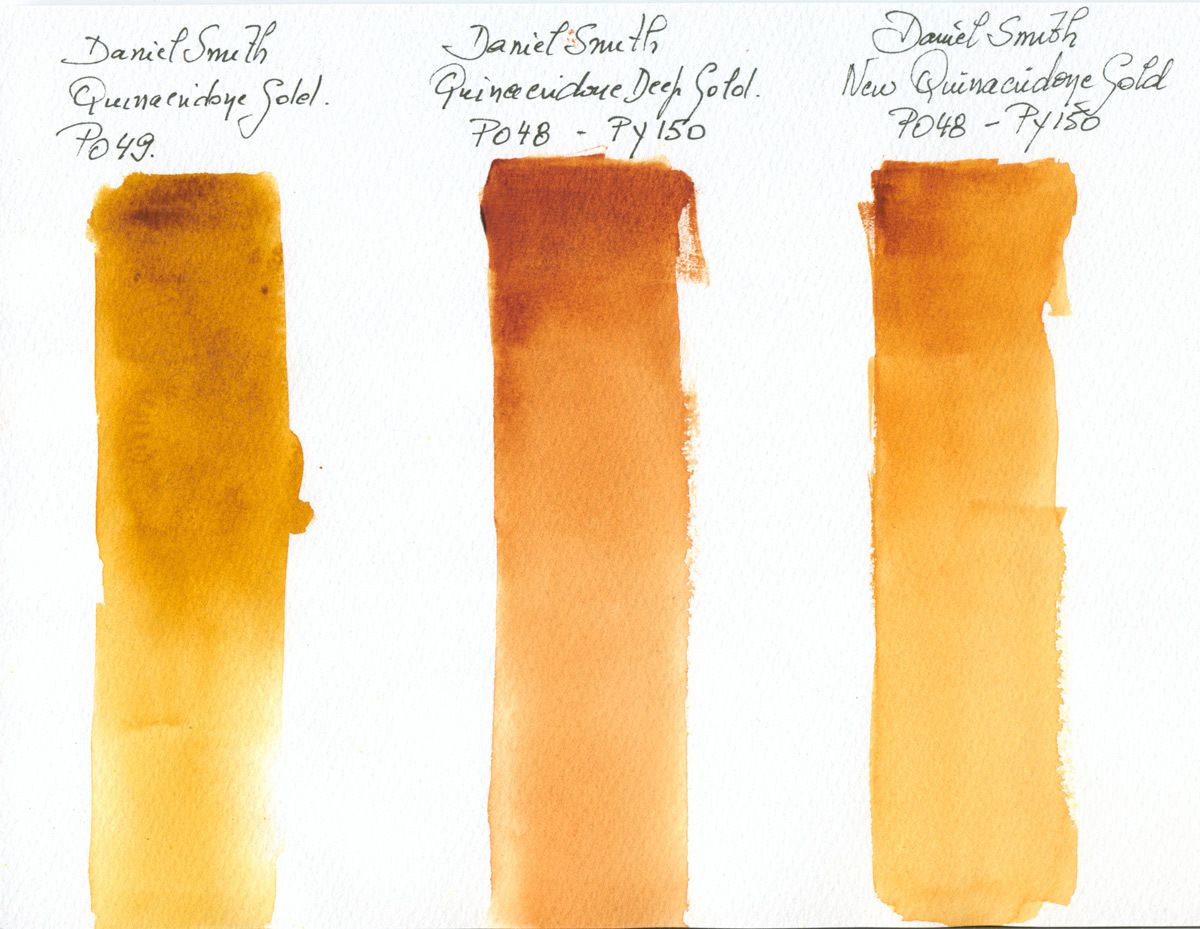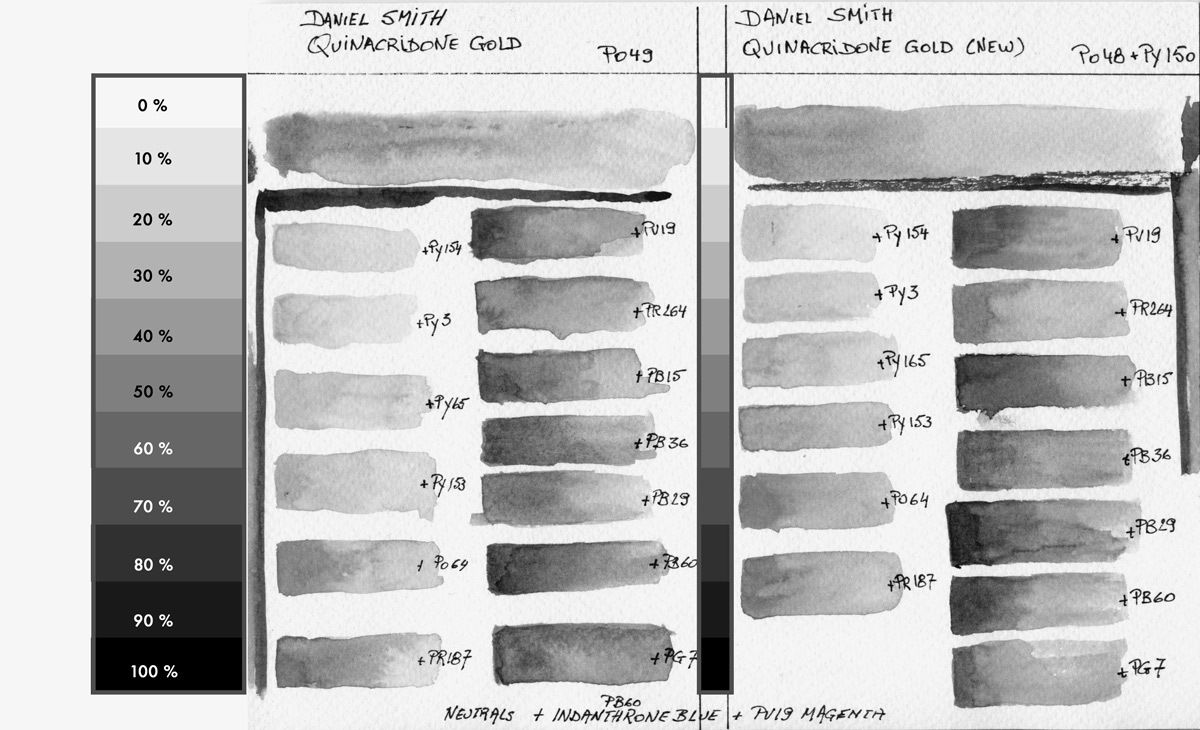Is Daniel Smith lying to us ? The Comparison of the New Quinacridone Gold to the Old One

Very recently during an internship with Catherine Rey, we were a dozen watercolorists to participate. To create green Catherine Rey asked us to use Indigo with permanent yellow and gum gutte. What was the disillusionment of some painters ... the mixtures obtained were not at all close to the mixtures obtained by the artist ...
Yes a name does not say anything, some brands use other pigments than their normal used to compose a certain paint. Result is that the mixture obtained is very different from the mixtures with the same name produced by other brands. To this is added shortly the difference between the same name, but with a different formulation.
This will be the basis of another article, but let's go back to Daniel Smith's Quinacridone Gold. I had mentioned in my previous article the change of formula following the exhaustion of the pigment PO49. Since then I have received a tube of the new formulation and I made some comparisons and tests.
Daniel Smith indicates that there is very little difference between these two formulas. I was already more dubious, because adding a pigment more and not in the same shade (yellow instead of orange) would certainly play especially with the opposite, see the green ....
I painted large samples, then mixed with my limited palette of 13 colours (see the composition here). I also add a conversion in gray level in order to be able to see the value of the hues.
In my observations I use the following denominations QG = Quinacridone Gold old PO49 and QGN = Quinacridone Gold New PO48 + PY 150

My observations
Pure color are very close, especially when using a creamy dilution. But when you dilute the Quinacridones Gold a lot, the old PO49 is more nuanced and a little less yellow with a tendency towards the yellow ocher more pronounced. The new hue is closer to a golden order.
Mixes
- Mix with the PY154: the two Quinacridones Gold have the same behaviour, difficult to find a difference
- Mix with the PY3: quite similar but the QG produce a more cold yellow (trend + lemon) than the QGN which is a little more red (It is the PY150 Azo Yellow which is more red) which must be the factor of this shade a little more red)
- Mix with the PY65: same observation as with the PY3 in addition to the level of the shade (see the conversion in gray tones) the mixture with the HQ is clearer than with the QGN
- Mix with the PY153: the QG is less red than the QGN the HQ tone is also clearer.
- Mix with PO64: mixing with QG is less orange and more nuanced.
- Mix with the PR187: the mixes are a little redder for the slightly more neutral QG for the QNG but the differences are really very slight.
- Mix with the PV19: a shade more Terra Cota, burnt scarlet for the QNG the QG to a more rosy hue
- Mix with PR264: darker shade for slightly redder QG. QGN tends to be a bit more yellow
- Mix with PB15: HQ produces a really different mix. The resulting green is between a bluish green and an olive green, with a more yellow tendency. The mix with the QGN produces a more neutral green close to a green Hooker with a small Viridian (blueish) trend.
- Mix with PB36: The mixture with QG produces a yellow olive green tendency with a nice separation with cerulean granulation. Less granulation / separation for mixing with QGN producing a more blue tinting resulting in a green with a lighter yellow dominant
- Mix with PB29 The mixture with QG produces a slightly green shade of natural umber. The result with the QGN produces a dark green between Perylene Green and Hooker's Green
- Mix with PB60: The blend with QG produces a shade similar to a natural shade with a yellowish green tendency and a noticeably darker hue than the blend produced with QGN, which produces a near-neutral chrome green.
- Mix with the PG7: The QG produces in this mixture a very nice green yellow broken close to a very dense olive green. The QGN produces a Spinell green with a more yellow tone, very useful for a spring green.
And last but not least, I tried to create neutrals close to black with PV19 pigments and PB60. The mix with the QGN is more blue, the QG produces a more neutral tone with a slight tendency towards green. The hue created with the HQ is also denser approaching 90% very useful to create a tinted black in your landscapes.

Conclusion:
The new Quinacridone Gold shade is very different from the old one. If we do not see any difference in using it pure, we clearly see a different behaviour when we use it in mixtures. The addition of yellow Azo (PY150) produces slight differences in the mixtures with the yellows and reds, but the biggest differences are found in blends with blues. The old Quinacridone Gold produces olive green tones turning to a greenish shade of umber, while the new Quinacridone Gold produces green from sap green to perylene green.
The new quinacridone gold from Daniel Smith can not replace the old one if it is used in mixtures. We lose the slightly broken shades, characteristic of this colour. The new one does not break the colours, their result is closer to pure hues. At the level of transparency the 2 are comparable.
Now it's up to you to see if you will keep Daniel Smith's new Quinacridone Gold in your palette ...
